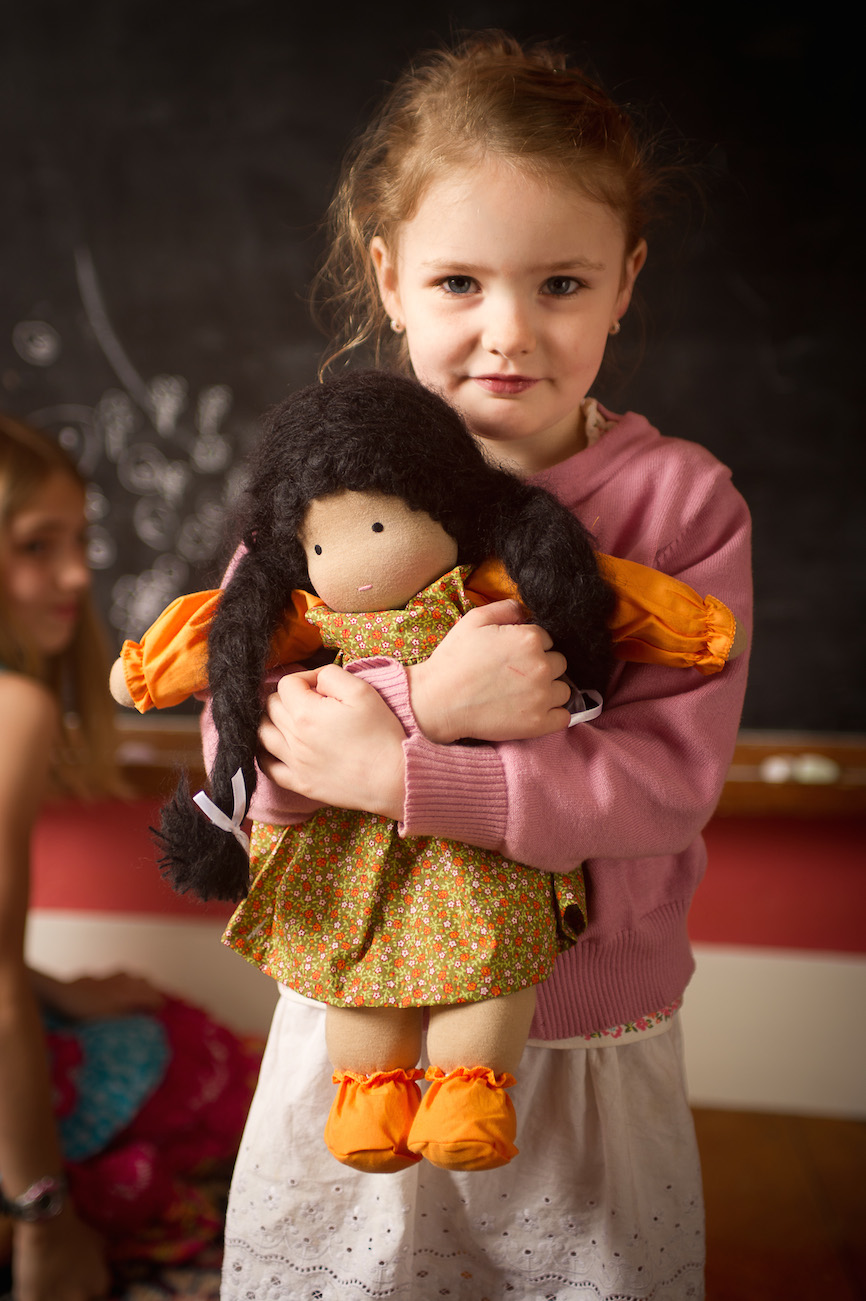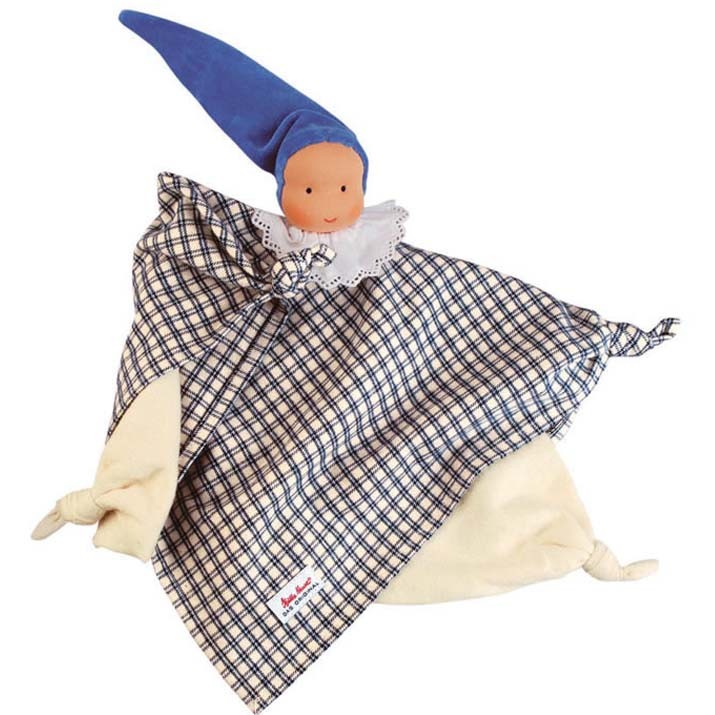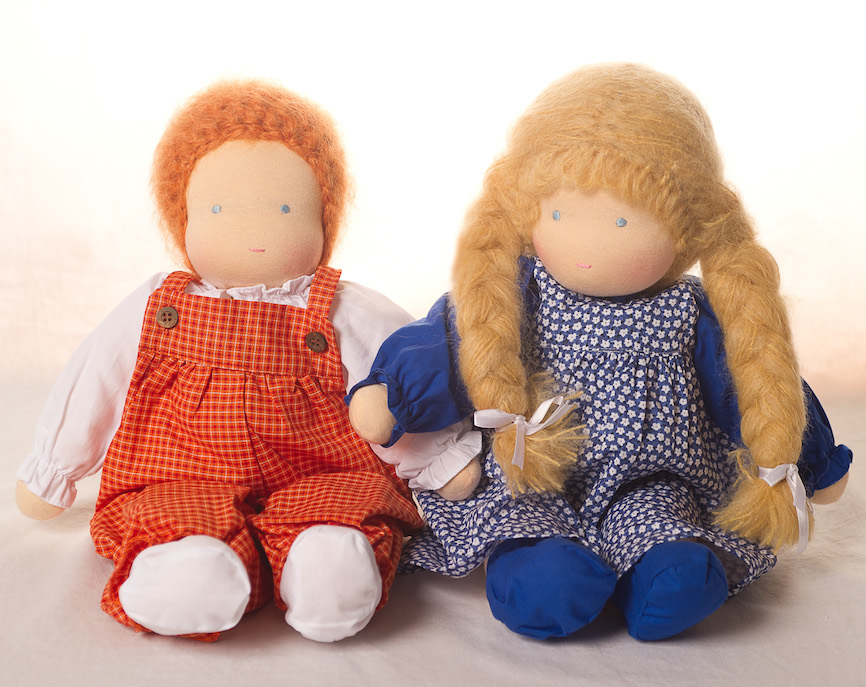A Waldorf doll may be the first thing that comes to mind when one thinks of “Waldorf toys.” I often receive inquiries about Waldorf dolls and how to choose one. Here, I share with you some of the common questions, and my responses.
Q: What exactly is a Waldorf doll?
A: A Waldorf doll is a type of doll used in Waldorf education. They are usually handmade of natural fibers, like wool and cotton, using traditional European dollmaking techniques.
The facial features of a Waldorf doll are intentionally minimal (for example, two embroidered eyes, and a hint of a mouth) or they may have no facial features at all! This is to allow a child to develop his or her capacity for imagination and creativity. Without fixed facial features, a child can imagine the doll to have any expression. It is equally easy to imagine such a doll being happy or sad; crying or laughing—unlike a hard plastic doll, with a fixed, permanent expression.
Q: When is a good time to introduce a doll for the first time? Which dolls would you recommend for different ages?
A: One can introduce a doll to a baby during the first year! I always recommend a Waldorf Blanket Doll as the perfect first doll for a baby, and up to the age of two.
Sometimes known as a “Towel Doll,” a Blanket Doll is a cross between a favorite “blankie” and a doll. Babies love to look at the human face, and this doll has a formed head covered with cotton knit skin and hand-sewn simple facial features. It has an unformed, soft flannel body, and simple hands and feet sewn into the four corners. The cotton flannel body is warm and soft, and nourishing to a baby’s developing senses. The hands and feet invite gumming and chewing, and the materials are safe and non-toxic.
A toddler at the age of two or three can more easily grasp the concept of “doll,” and at this age I recommend a Waldorf Cuddle Doll. This type of Waldorf doll (which is also known as a “Bunting Doll”) is more huggable, and squeezable. The body is pillow-like and squishy, making it easy for a young child to hold and grasp. The knot at the end of this “baby’s” stocking cape invites gumming and mouthing, and like the Blanket Doll, is safe for doing so.
For a child age four or older, I recommend a beautiful and classic Waldorf Dress Up Doll. The “dress up” doll typically has skin made from cotton interlock knit fabric and wool stuffing. The trademark long hair on the girl dolls is usually made of mohair or boucle, and can be braided. It has flexible arms and legs, allowing the doll to be dressed in different changes of clothing, and to assume natural postures.
It is between the ages of 4 and 6 when children really start to play imaginatively and out of imitation. This is the age when playing “house” usually begins, and children of this age love to dress and change clothes on these dolls, feeding them, having tea parties with them, and so forth. These dolls are ideal for a child who has developed the fine motor skills needed to button and change clothing. In doing so, children further develop these skills of manual dexterity.
Q: My daughter’s doll has some dirt stains on her face and body. Can you tell me how to safely wash a Waldorf doll?
A: Waldorf dolls are generally surface washable only. The best way to wash them is to gently spot clean with a mild soap (I like Dr. Bronner’s liquid castile soap, used very diluted in water) and a soft terrycloth rag. Allow the doll to air dry away from direct sunlight. Never, ever put a Waldorf doll in a washing machine or dryer!
I love hearing your questions! Have a question about Waldorf toys or Waldorf education? A perplexing parenting problem? Wondering about your child’s development? Leave your question here and I’ll do my best to answer in a future post.







12 Comments
Dear Sarah,
What a timely post! I have been thinking of how to introduce and what type of doll to my 5 year old son. He has not been interested in dolls so far, even though his first “toy” was a blanket doll just after his birth, which he still loves.
Now he has become a big brother to a little girl and I was wondering if I should try to introduce a baby doll, or dress up doll to him where he could imitate me in the day to day events with his sister.
I also heard that it is best to get a doll of the same sex for the child, for example a boy doll for a boy and a girl doll for a girl, but my son wanted a little sister and is also more interested in a girl doll rather than a boy doll, so he says.
I have bought him a little friend previously but he is not interested in it all, so I am worried to purchase another doll for him, as it might just end up in a corner like his last doll.
I am at a loss really, what would you suggest?
Warmly,
Maggie
Glad you found the post timely, Maggie!
Most parents do like to choose dolls that resemble their child in terms of gender and coloring, but in my experience, children seem rather unaware of such similarities. I’m thinking of one little girl with short curly dark brown hair, whose favorite and much-loved doll had long, bright red hair.
When it comes to boys and dolls, my feeling is that every boy ought to have at least one doll. But a boy’s relationship to a doll is much less predictable than a girl’s. Some boys can become very attached to a doll and others will show little interest. But I think that a doll for a boy who has an infant sibling is particularly beneficial, since he will spend so much time watching Mama care for the baby, and children naturally want to imitate the work of the adults whose company they share.
Thank you for a great article! We are going to link this to our LILIPOH magazine Facebook page!
Thank you, Christy, for the link! I am a big fan of LILIPOH.
Thank you for your answer Sarah!
Now the only consideration to take into account is if I should be getting a baby doll for my son, like his little baby sister, or one of the above fully formed dolls with limbs….?
Thank you for your help!
Maggie
I love these soft little babies. Both my sons have one that that have beside our family bed.
Congratulations on all your children’s graduations.
[…] founder of Bella Luna Toys, is an experienced Waldorf teacher and mother. Please read her article “An Introduction to Waldorf Dolls” for more information. Bella Luna Toys is a great resource for toys fostering motor skill […]
I need some advice. A friend of mine has a three year old daughter with Autism. They don’t have very much money, so I thought of making her a doll or stuffed animal out of natural materials. The toy needs to be simple enough for a beginer (me) to sew,but also needs to be safe for a child who still mouths objects. What structure/ features would you recommend? Also, where can you buy materials/ patterns (stores preferred)? Any help would be greatly appreciated.
Hello! I know this posting was a while ago but I’m trying to find an answer to a question and haven’t been able to pin it down yet. I made my children, now 8 & 9, a Waldorf cuddle doll when they were younger and they still occasionally play with them. I’ve been meaning to get or make an actual Waldorf doll for them, especially now that they have a new sibling on the way. My question is what age I should have the Waldorf doll be…a baby looking Waldorf doll or a more kid looking Waldorf doll.
Thanks for your question, Joscyln. For an 8- or 9-year-old, I would recommend making them a classic Dress-Up Waldorf Doll, for which you can make or buy clothes and change them. Older girls love to braid and comb the hair of these dolls. Hope you’ll come back and share pictures of the dolls you make!
Hi there
I was wondering about sizing of the dolls. Is there specific sizes you recommend for different age groups? I’m hoping to make a doll for my 3 year old but can’t decide what size to go for, I don’t think I will make another when she is older so I would like her to be able to grow with this doll if that makes sense.
Many thanks in advance.
Thanks for your question, Lula. Sorry for the delay in responding! How wonderful that you want to make a doll for your daughter! For a three-year-old, I would recommend making a cuddle or bunting doll about 12 inches long. You may find that after making one doll, you want make more! But if you don’t think you will ever make another doll and will make only one doll, then you might want to make a Classic Waldorf Dress-up Doll that she can grow into. Keep in mind that most three-year-olds will not have the interest in or dexterity for dressing and undressing a doll, but this will change quickly with time. After you have made your doll, please share a photo here!